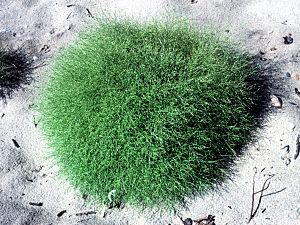Winged pigweed facts for kids
Quick facts for kids Winged pigweed |
|
|---|---|
 |
|
| Scientific classification | |
| Genus: |
Cycloloma
|
| Species: |
atriplicifolium
|
| Synonyms | |
|
|
Cycloloma atriplicifolium, often called winged pigweed or tumbleweed, is a unique plant. It is the only species in its group, called a monotypic genus. This plant is well-known for turning into a tumbleweed when it dries out.
It originally grew in the middle parts of North America. However, it has spread to many other places. You can now find it from California all the way to Maine and even in Canada. In areas outside its original home, it is known as an introduced species.
This plant is an annual herb, meaning it lives for only one growing season. It grows into a bushy, rounded shape and can be over half a meter tall. Its stems branch out in many directions. Near the bottom of the plant, you'll find leaves with small teeth along their edges. The stems also have small flowers and young fruits. These fruits have a thin, almost clear wing around them.
What is a Tumbleweed?
In the autumn, after the plant has grown and produced seeds, it dries up. The entire plant then breaks off from its roots. It becomes a light, round shape that the wind can easily blow across open land. This is how it gets its common name, tumbleweed. As it tumbles, it scatters its seeds far and wide. This helps the plant spread to new places.
The fruit of the winged pigweed is very small, about 2 millimeters long. It is called a utricle and holds just one seed inside.
How People Use Winged Pigweed
For a long time, Native American peoples have used the seeds of the winged pigweed as a food source. The Zuni and Hopi tribes are two examples.
- The Zuni people often mix the seeds with ground corn. They use this mixture to make a soft, thick food called mush.
- They also grind the seeds and mix them with cornmeal. Then, they shape this mixture into cakes and cook them by steaming.
- The Zuni also have a special traditional use for the plant's blossoms. They chew the blossoms and rub them on their hands. This is done for protection in certain ceremonies.

